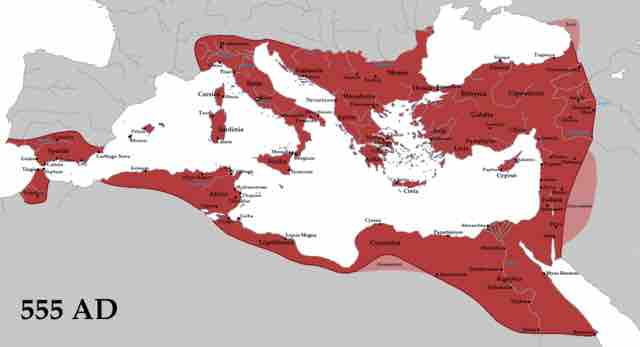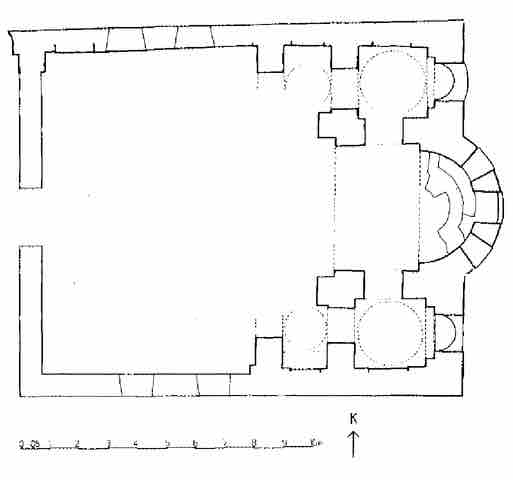After the death of Theodosius I in 395, the Roman Empire was divided into an Eastern half based in Constantinople and a Western half based in Rome. Less than a century later, in 476, the last Western emperor Romulus Augustulus abdicated to a Germanic warlord who placed his own rule under that of the Eastern emperor. This act effectively ended the line of Western emperors and marked the end of the Western Empire. However, the Eastern portion (what historians call the Byzantine Empire) would continue for approximately another millennium.

Byzantine Empire at its height
The Byzantine Empire (red) and its vassals (pink) in 555 CE during the reign of Justinian I.
The word Byzantine derives from Byzantium, the original name of Constantinople before Constantine moved the Roman imperial capital there in the fourth century. Despite this present-day appellation, those living within the borders of the Byzantine Empire did not call themselves "Byzantine." They continued to call themselves Romans and, until the early seventh century, continued to speak Latin. Even Roman Catholicism remained the official religion of the Byzantine Empire until the eleventh century.
In an effort to recreate a unified Roman Empire, Justinian I (r. 527–565) was able to reconquer most of the Mediterranean coast, including North Africa, Rome, and southern Spain. This swath of territory remained in the Byzantine Empire for two centuries. A significant cultural shift occurred in the early seventh century when Heraclius (r. 610–641) replaced Latin with Greek as the official language of the Empire. Religious tensions with the Church in Rome began in the fourth century, resulting in seven Ecumenical Councils over six hundred years. Finally, in 1054, the East-West Schism officially made the Eastern Orthodox Church, centered in Constantinople, its own separate entity from the Roman Catholic Church.
From the tenth century to the fifteenth, the empire experienced periods of peace and prosperity, as well as war and economic downturns. In the late eleventh century, the empire lost much of Asia Minor to the Turks, a temporary setback that foreshadowed the ventral weakening of Constantinople and further loss of territory to the growing Ottoman Empire. In 1453, the Ottoman Turks invaded and captured Constantinople, bringing the Byzantine Empire to an end.
Byzantine Art and Architecture
Surviving Byzantine art is mostly religious and, for the most part, highly conventionalized, following traditional models that translate carefully controlled church theology into artistic terms. Painting in fresco, mosaic, and illuminated manuscripts and on wood panel were the main two-dimensional media. Manuscript painting preserved some of the classical realist tradition that was missing in larger works. Figurative sculpture was very rare except for small carved ivories.
Byzantine art was highly prestigious and sought-after in Western Europe, where it maintained a continuous influence on medieval art until near the end of the period. This was especially true in Italy, where Byzantine styles persisted in modified form through the twelfth century. However, few incoming influences affected Byzantine style. By means of the expansion of the Eastern Orthodox church, Byzantine forms and styles spread throughout the Orthodox world and beyond.
Ascension scene from the Rabula Gospel
Miniatures of the sixth-century Rabula Gospel display the more abstract and symbolic nature of Byzantine art.
Early Byzantine architecture drew upon earlier elements of Roman architecture. After the fall of the Western Empire, several churches, including the Hagia Sophia in Constantinople and San Vitale in Ravenna, were built as centrally-planned structures. However, stylistic drift, technological advancement, and political and territorial changes gradually resulted in the Greek-cross plan in church architecture.
Buildings increased in geometric complexity. Brick and plaster were used in addition to stone in the decoration of important public structures. Classical orders were used more freely. Mosaics replaced carved decoration. Complex domes rested upon massive piers, and windows filtered light through thin sheets of alabaster to softly illuminate interiors. Influences from Byzantine architecture, particularly in religious buildings, can be found in diverse regions from Egypt and Arabia to Russia and Romania. Most of the surviving structures are sacred in nature, with secular buildings mostly known only through contemporaneous descriptions.

Plan of the katholikon church of the Pelekete monastery
The plan of katholikon church provides the typical layout of Byzantine churches after the eighth century. Tirilye, Turkey.